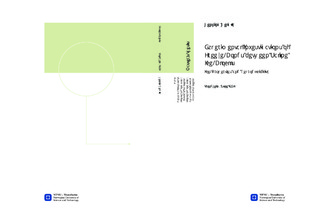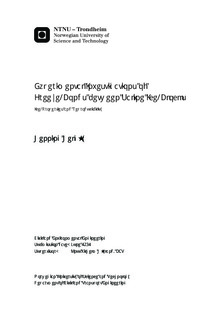| dc.description.abstract | This thesis presents and analyse laboratory investigations of the shear strength of freeze-bonds created between two saline ice-blocks. One hundred and eighty one experiments were conducted during spring 2012 in the ice laboratory at NTNU and at Hamburg Ship Model Basin (HSVA). The applied experimental setup is similar to the set-up used by Repetto-Llamazares et al. (2011a) and Repetto-Llamazares and Høyland (2011a). The reproducibility of the measurements from these articles and how the freeze-bond strength varies with the physical properties of the ice used to form freeze-bonds were investigated. Investigating the physical properties of the ice involved temperature, salinity and density measurements, thin section analysis and characterisation of the visual appearance of the ice. We consider our results to be important knowledge for future work to perform more accurate small-scale experiments on freeze-bonds. The measured freeze-bond strengths had a range of 1.9 to 94.9 kPa.The following factors were varied during the experiments: a) Two sample dimensions were used: small ice-blocks with dimensions of 60 · 40 · 22 [mm] and 90 · 40 · 22 [mm], with a nominal contact area between the ice-blocks of 60 · 40 [mm], and large ice-blocks with dimensions of 140 · 140 · 27 [mm] and 180 · 140 · 27 [mm], and a nominal contact area between the ice blocks of 140 · 140 [mm]; b) Three contact surfaces were used: artificially produced and the natural top or bottom of the ice-sheet. Groves made during sawing of the artificially prepared surfaces were either normal to or parallel with the longitudinal ice-block direction; c) Two ice-blocks directions were made by having the longitudinal ice-block direction normal to or parallel with the ice-growth direction; d) Assembling the freeze-bond was made by placing the ice-blocks in contact with each other in water or in air; e) The water temperature in the submersion basin was either on, or slightly above the freezing point; f) Changing the time - temperature historie of the ice-blocks were done by either storing the ice at −7 C at all time or for a defined period of time cooling the ice-blocks down to −20 C. The initial ice-block temperature of −7 C, submersion time of 10 min, confinement pressure during submersion of 1.9 kPa and a velocity of the force applying piston of 2 mm/s were kept constant, and are equal to Repetto-Llamazares and Høyland (2011a).Physical properties of the freeze-bonding ice-blocks influenced the freeze-bond strength. Weak freeze-bonds were obtained for ice-blocks with a low initial salinity (S < 1 ppt), and strong freeze-bonds were obtained if the ice-blocks had a high initial salinity (S > 2 ppt). The low salinity ice-blocks were in addition seen to have a transparent look and few brine channels and voids. High salinity ice-blocks had an opaque look and contained many brine channels and voids. Keeping the longitudinal ice-block direction normal to the ice-growth direction, and assembling the samples in water gave stronger freeze-bonds. Freeze-bonds created between two natural bottom surfaces gave the strongest freeze-bonds, while the weakest freeze-bonds were obtained for the artificially prepared surfaces. Surfaces with an initially high surface roughness gave weaker freeze-bonds. The grove direction of the artificially prepared surfaces, the water temperature in the submersion basin, the sample size and the time - temperature history of the ice-blocks did not affect the freeze-bond strength.We did not manage to reproduce the results of Repetto-Llamazares et al. (2011a) and of Repetto-Llamazares and Høyland (2011a). Different submersion time (5 vs. 10 min) and confinement pressure (0.66 vs. 1.9 kPa) in the experiments of Repetto-Llamazares et al. (2011a) and us are probably the main reasons for the observed differences. We believe that comparable freeze-bond strengths would be obtained if identical test parameters had been applied. We do from this consider the experiments of Repetto-Llamazares et al. (2011a) to be reproducible.Repetto-Llamazares and Høyland (2011a) reports a very low average freeze-bond strength, 3.6 kPa, for the submersion time, confinement pressure, initial ice-block temperature and piston velocity applied in our thesis. We have not been able to obtain such low average freeze-bond strengths. We believe that the low freeze-bond strengths obtained by Repetto-Llamazares and Høyland (2011a) is an effect of the physical properties of the ice-blocks applied in their experiments, i.e. transparent ice-blocks with a low salinity. | nb_NO |

